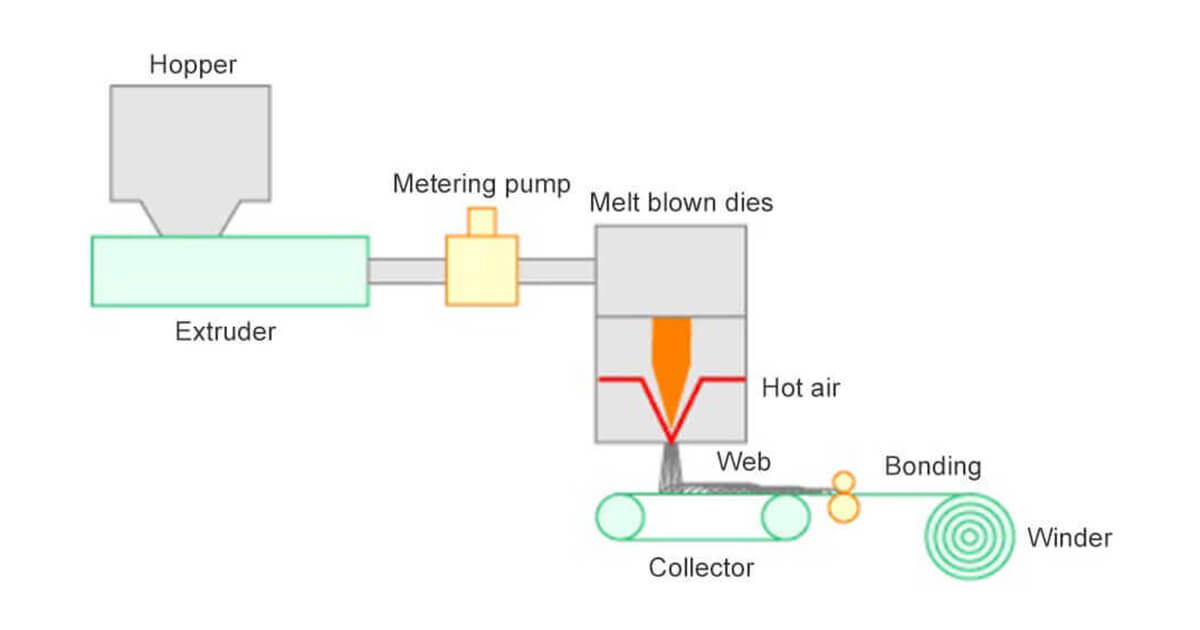



Above picture shows the melt blown fabrics production process. Here we are talking about the fibers drafting by high-temperature and high-speed airflow. Taking Exxon's melt-blown system as an example, the draft airflow is symmetrically blown from both sides of the melt stream at a certain angle, and the fiber is drawn by the airflow clamping.
Due to the small diameter of the meltblown fiber, the draft airflow is required to have a very high speed (generally at subsonic or close to the speed of sound, or even beyond the range of the speed of sound), so the draft airflow is required to have a higher pressure, but compared with spunbond method, the flow rate of the drafting is much smaller, generally only in the range of 1000 ~ 2000m3/(h·m).
Effect of Draft Airflow on Melt Blown Fabric Quality
1. Effect on Fiber Fineness
The primary fiber from the melt-blown spinneret is drawn by hot air at high temperature and high speed.
Wind speed and wind temperature will affect the fineness of the fiber. Under the conditions of high wind volume, high wind speed and high wind temperature, finer fibers can be produced. Within a certain range, as the flow (or pressure) of the draft airflow increases, the fiber size will become thinner.
Note that when the flow (or pressure) of the draft airflow increases to a certain value, some fibers are blown away by the airflow due to excessive drafting, and some fibers will become thicker, because the fibers are broken as soon as it leaves the outlet of the spinneret hole, which is very detrimental to the quality of the product.
When the wind volume and wind speed of the draft wind are larger, or the wind temperature is higher, the linear density of the fiber becomes smaller, the vertical and horizontal strength increases, and the energy consumed per unit product increases. In addition to the three factors of the wind site, wind speed and wind temperature of the draft wind, the fineness of the fiber is also related to the single-hole extrusion of the spinneret.
In actual production, sometimes in order to obtain finer fibers, the amount of single-hole extrusion should be reduced, resulting in a decrease in output and increasing the cost of the product. The uniformity and stability of the draft airflow will affect the uniformity of the laying of the net, and have a great influence on the uniformity of the melt-blown fabric. But in most cases, the uniformity of the melt-blown non-woven fabric is better than the spun-bonded non-woven fabric.
2. Effect on product hydrostatic pressure
One of important applications of the melt blown fabric is barrier product. The barrier performance of the product is often expressed by hydrostatic pressure. The higher the hydrostatic pressure, the better the barrier performance.
As the temperature of the draft airflow rises, the melt flow performance becomes better, and the fibers are easier to draft, producing finer fibers, which increases the product's hydrostatic pressure.
In the same way, increasing the flow rate of the draft airflow can not only provide more heat energy to the melt, make the melt flow better, but also increase the speed of the draft airflow, which is conducive to the formation of finer fibers and denser web structure.
Note that with the increase of the draft air flow, thinner fibers can be generated, and the hydrostatic pressure of the product is increased. However, excessively increasing the flow rate will cause a large number of fiber breaks, which reduces the hydrostatic pressure.